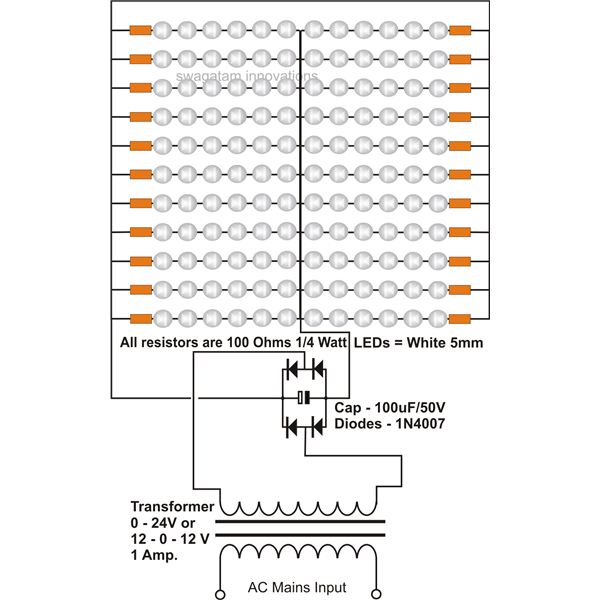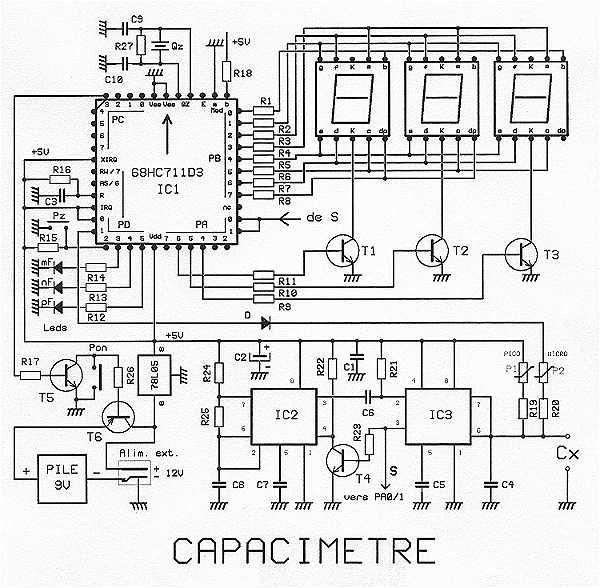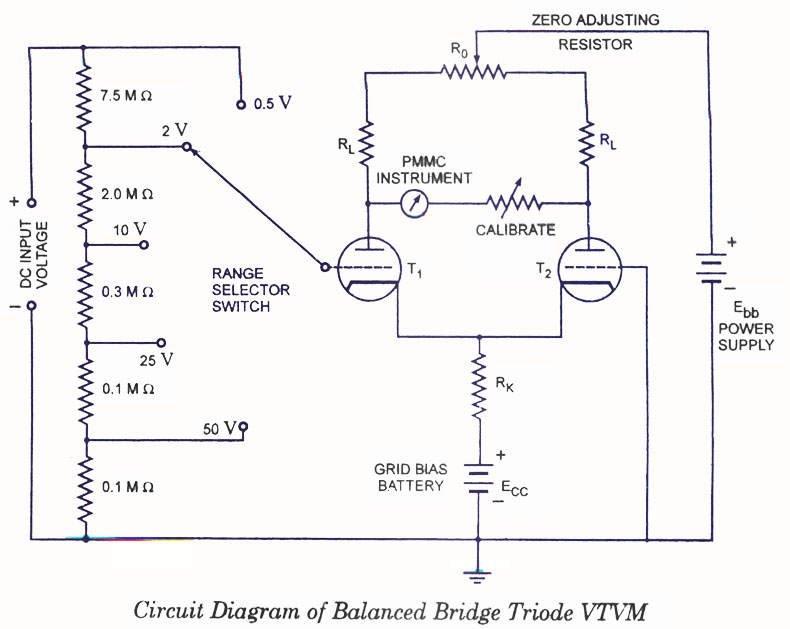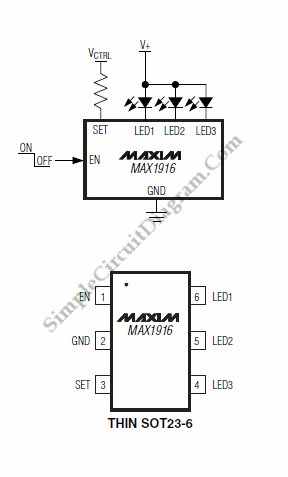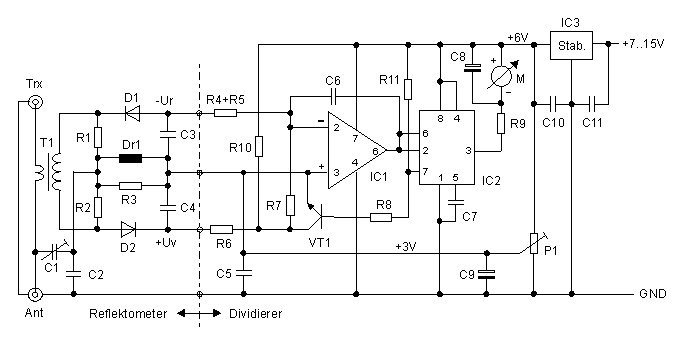
40 segment led s meter
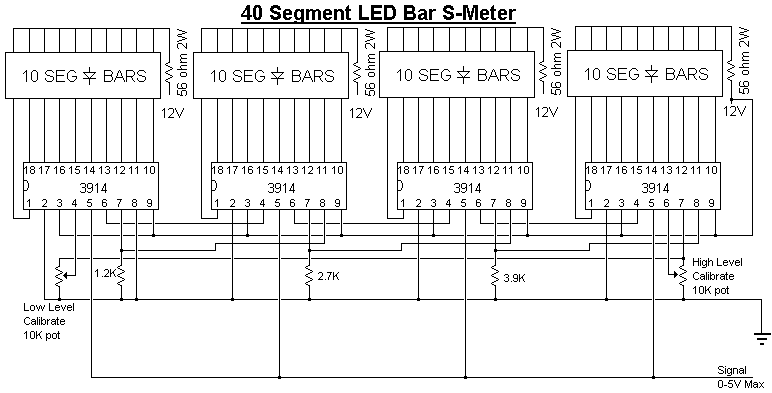
Provide your radio with an actual cord signal. First, adjust the HIGH LEVEL potentiometer to the point where all LEDs are illuminated. Then, completely remove the signal and adjust the LOW LEVEL potentiometer until no LEDs are lit. If the S-meter reading of your radio exceeds 5 volts, consider replacing the HIGH LEVEL potentiometer with a 10K resistor. Connect pin 6 of the right-most 3914 to the cathode of a 6.1-volt zener diode, which should be pulled up to 13 volts using a 1K resistor. The anode of the zener diode should be connected to ground. A higher voltage zener diode may be used if necessary. This configuration allows for 10mA per LED segment. Adjust the values of the resistors and potentiometers to modify the current supplied to the LEDs. R1 = 12.5/I, R2 = 25/I, R3 = 37.5/I, R4 = 50/I, where I represents the desired LED current.
The circuit described involves a radio signal processing system that utilizes a series of LEDs to provide visual feedback based on the signal strength detected by the S-meter. The HIGH LEVEL potentiometer is critical for setting the maximum threshold at which all LEDs are illuminated, indicating optimal signal reception. Conversely, the LOW LEVEL potentiometer serves to define the minimum threshold, ensuring that no LEDs are lit when the signal falls below a certain level.
The use of a 10K resistor in place of the HIGH LEVEL potentiometer is advisable when the S-meter voltage exceeds 5 volts, as this adjustment helps to protect the circuit from potential damage due to excessive current. The integration of a 6.1-volt zener diode, connected in a specific manner, ensures that the voltage levels remain stable and within safe operating parameters. The 1K resistor pulling the zener diode up to 13 volts plays a crucial role in maintaining the voltage supply, while grounding the anode provides a reference point for the circuit.
The circuit's design allows for flexibility in current management through the use of adjustable resistors and potentiometers. The specified values for R1, R2, R3, and R4 indicate the relationship between the resistance and the desired LED current, allowing for precise control over the brightness and responsiveness of each LED segment. This adaptability is essential for tailoring the circuit to specific operational requirements and ensuring optimal performance in various signal conditions.Provide your radio with a actual cord signal, again acclimatize the HIGH LEVEL pot to the beginning of anecdotic the aftermost LED (all LEDs on). Remove the arresting completely, again acclimatize the LOW LEVEL pot to the beginning of no LEDs illuminated.
If your radios S-meter achievement is greater than 5 volts, you mau ambition to alter the HIG H LEVEL pot with a 10K resistor, and accommodate pin 6 of the right-most 3914 with the cathode of a 6. 1 volt zener diode, pulled up to 13 volts with a 1K resistor. The anode should be affiliated to ground. You may use a college voltage zener if necessary. This agreement provides 10ma per LED segment. Change the ethics to the resistors and pots to change the drive accepted to the LEDs. R1=12. 5/I R2=25/I R3=37. 5/I R4=50/I area I = the adapted LED current 🔗 External reference
The circuit described involves a radio signal processing system that utilizes a series of LEDs to provide visual feedback based on the signal strength detected by the S-meter. The HIGH LEVEL potentiometer is critical for setting the maximum threshold at which all LEDs are illuminated, indicating optimal signal reception. Conversely, the LOW LEVEL potentiometer serves to define the minimum threshold, ensuring that no LEDs are lit when the signal falls below a certain level.
The use of a 10K resistor in place of the HIGH LEVEL potentiometer is advisable when the S-meter voltage exceeds 5 volts, as this adjustment helps to protect the circuit from potential damage due to excessive current. The integration of a 6.1-volt zener diode, connected in a specific manner, ensures that the voltage levels remain stable and within safe operating parameters. The 1K resistor pulling the zener diode up to 13 volts plays a crucial role in maintaining the voltage supply, while grounding the anode provides a reference point for the circuit.
The circuit's design allows for flexibility in current management through the use of adjustable resistors and potentiometers. The specified values for R1, R2, R3, and R4 indicate the relationship between the resistance and the desired LED current, allowing for precise control over the brightness and responsiveness of each LED segment. This adaptability is essential for tailoring the circuit to specific operational requirements and ensuring optimal performance in various signal conditions.Provide your radio with a actual cord signal, again acclimatize the HIGH LEVEL pot to the beginning of anecdotic the aftermost LED (all LEDs on). Remove the arresting completely, again acclimatize the LOW LEVEL pot to the beginning of no LEDs illuminated.
If your radios S-meter achievement is greater than 5 volts, you mau ambition to alter the HIG H LEVEL pot with a 10K resistor, and accommodate pin 6 of the right-most 3914 with the cathode of a 6. 1 volt zener diode, pulled up to 13 volts with a 1K resistor. The anode should be affiliated to ground. You may use a college voltage zener if necessary. This agreement provides 10ma per LED segment. Change the ethics to the resistors and pots to change the drive accepted to the LEDs. R1=12. 5/I R2=25/I R3=37. 5/I R4=50/I area I = the adapted LED current 🔗 External reference
Warning: include(partials/cookie-banner.php): Failed to open stream: Permission denied in /var/www/html/nextgr/view-circuit.php on line 713
Warning: include(): Failed opening 'partials/cookie-banner.php' for inclusion (include_path='.:/usr/share/php') in /var/www/html/nextgr/view-circuit.php on line 713
